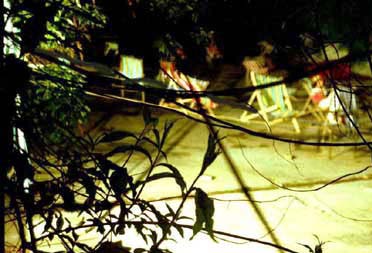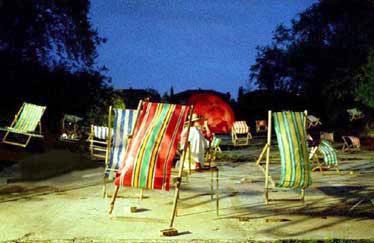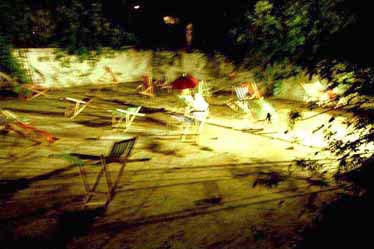Hilary Powell
 |
“Ocean Me” is a slogan graffitied on the walls of a now drained and empty outdoor swimming
pool –The Lido in London Fields, Hackney. This is a specific example
of the interaction or relationship between art and site, or, “event”
and “junkspace”. The rise of the lidos in the 1920s were part of a well documented history of
social reform in east London in which the reformers and sanitarians
strived to create an antidote to rapid industrialisation. After the
first world war housing,education and health were priorities and in
the 1930s increased leisure time led to the development of mass leisure
facilities such as these Lido’s and holiday camps with emphasis on fitness
and national culture.
London Fields Lido was begun in 1928 and completed in 1936 . Within its red brick enclosure it housed a modern filtration plant for the Olympic size 50 foot pool and, as bathing dropped its macho facade and became a family pursuit it housed a cafe, spectator and sun bathing areas, flower beds and more than adequate changing facilities. In the 1980s, increased need for subsidy, changing leisure patterns in society and the rise of foreign travel and tourism left the Lido’s in disrepair and debt and in 1988 the London fields pool was closed. |
 |
Now, in the next Millenium it still lies closed. But not empty. Amid the burgeoning
budlia overhanging the empty basin of the pool there lives a group of
people termed as “squatters”. They inhabit the changing rooms and the
plant room, hold cafes on Sundays and are planting out the basin of
the pool with grass. Approaching the inhabitants for permission to use
this site to construct an installation they agreed and I began work
on Fleeting. This large scale installation involved the suspension of fifty colourfully
striped deckchairs across the swimming pool in fleet formation. Viewed
by night, these were lit by halogen lights with their canvas “sails”
billowing in the evening breeze to the composed soundtrack of 1930’s
romance tunes mixed with the echoes of swimming pools and seaside holidays
past (courtesy of BBC sound effects). Within this staged and strange
fleet a beautiful woman dressed in a long white dress with a red umbrella
took her place in her own deckchair within the fleet remaining there
swaying silently in her own world for the one evening duration of the
work.
Visitors commented in the surreal character of the piece, of a subtle juxtaposition
where the deckchairs should seem out of place suspended across an
empty swimming pool and yet were strangely in place and out of time
between the familiar and the unknown. The already present qualities
of a secret and idyllic garden were amplified along with the solitary
figure’s isolation or dislocation as she faced the deep end of the
pool instead of the open sea.. Although there was no fixed viewpoint
the circumnavigation the pool from above, glimpsing the chairs and
the woman through gaps in the under.(or over) growth allowed a distance
and suspension of disbelief to be retained.
|
|
The issue of theatricality is central to my specific practice and it is interesting
to note that such theatricality in art was shunned by Fried in the seminal
text ‘Art and Objecthood” as a degenerative process. He derides what he
terms monumental artificiality. This artificiality is evident in the scenographic
conception of architecture, object and event involved in my practice and
celebrated in the various processes of the reconfiguration of the natural.
Constructing fictional worlds from everyday objects in relationship to
the chosen sites I aim to create a transitory environment of amplified
atmosphere (linked to the
gesthamkunstwerk
>) in order to expose their alternative non functional use and potential. I believe
that such reaction to and action on dormant sites can rejuvenate the ideas
and attitudes surrounding them and it is perhaps here that the paradox
comes into play.
It is hard to deny a fundamental attraction to the derelict and when the entropic
programme is interrupted by actions outside of the realm of the temporary
event, the space and work develop instantaneous politics and ideologies.
In the Lido, the inhabitants have so far resisted eviction and avoided
pressure-that is until now, community action groups and developers attempt
to stake their claim at redevelopment. The arguments here are complex.
How can this site be best “put to use”? Questions of property, function
and social responsibility cannot be avoided. My original intervention
was simple, it has now become part of and indeed maybe inadvertently a
catalyst for increased discussion around and instability of the site.
Hilary Powell, 2003
Note: London Fields Lido has re-opend as a swimming lido in 2006 |
 |